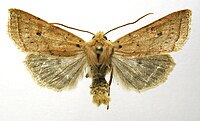Agrochola macilenta
| Agrochola macilenta | |
|---|---|

| |

| |
| Scientific classification | |
| Domain: | Eukaryota |
| Kingdom: | Animalia |
| Phylum: | Arthropoda |
| Class: | Insecta |
| Order: | Lepidoptera |
| Superfamily: | Noctuoidea |
| Family: | Noctuidae |
| Genus: | Agrochola |
| Species: | A. macilenta
|
| Binomial name | |
| Agrochola macilenta (Hübner, 1809)
| |
Agrochola macilenta, the yellow-line Quaker, is a moth of the family Noctuidae. The species was first described by Jacob Hübner in 1809. It is found in Europe (except Russia) and in Asia Minor.
The wingspan is 32–36 mm. Forewing ochreous washed with pale fulvous; the inner and outer lines very faint, marked chiefly by the dark teeth on the veins; a dark spot at base of wing; median shade variable; stigmata of the ground colour, with slight pale outlines, the lower end of the reniform nearly always black; submarginal line ochreous edged inwardly with rufous, nearly straight except for the angulation on vein 7; hindwing grey, the fringe rufous; — in the ab. nigrodentata Fuchs the basal, inner, and outer lines are all strongly marked, blackish and dentate.[1] The caterpillar is reddish brown with white dots, and three white lines on the back; the line along the spiracles is whitish with a dusky edge above. The head is ochreous brown and the plate on the first ring blackish lined with white.

The moth flies from September to December depending on the location.
The larvae feed on various shrubs and deciduous trees, including Carpinus, Crataegus, Fagus, Populus, Prunus, Ulmus, Salix, Quercus, Calluna, Hieracium and Plantago.[2]
References
[edit]- ^ Seitz, A. Ed., 1914 Die Großschmetterlinge der Erde, Verlag Alfred Kernen, Stuttgart Band 3: Abt. 1, Die Großschmetterlinge des palaearktischen Faunengebietes, Die palaearktischen eulenartigen Nachtfalter, 1914
- ^ Robinson, Gaden S.; Ackery, Phillip R.; Kitching, Ian J.; Beccaloni, George W. & Hernández, Luis M. (2010). "Search the database - introduction and help". HOSTS - A Database of the World's Lepidopteran Hostplants. Natural History Museum, London.
External links
[edit]- Kimber, Ian. "73.190 BF2264 Yellow-line Quaker Agrochola macilenta (Hübner, [1809])". UKMoths. Retrieved 22 January 2021.
- "Agrochola macilenta (Hübner, 1809)". Catalogue of the Lepidoptera of Belgium. Archived from the original on May 12, 2017.
- "09571 Agrochola macilenta (Hübner, [1809]) - Gelbbraune Herbsteule". Lepiforum e. V. Retrieved 22 January 2021. (in German)
- "Geelbruine herfstuil Agrochola macilenta". De Vlinderstichting. Retrieved 22 January 2021. (in Dutch)
